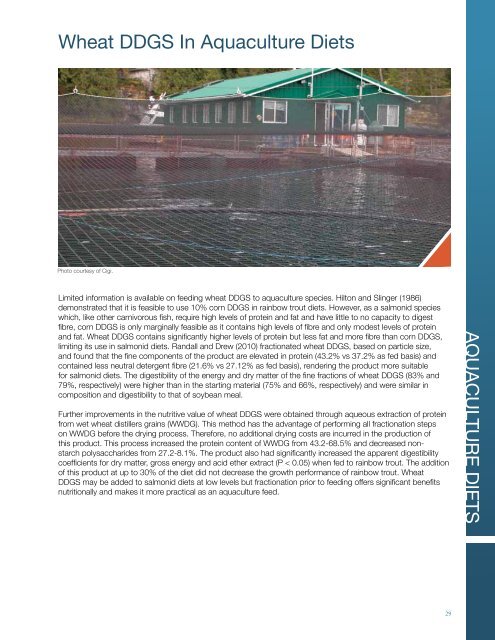Wheat DDGS Feed Guide - Western Canadian Feed Innovation ...
Wheat DDGS Feed Guide - Western Canadian Feed Innovation ...
Wheat DDGS Feed Guide - Western Canadian Feed Innovation ...
Create successful ePaper yourself
Turn your PDF publications into a flip-book with our unique Google optimized e-Paper software.
<strong>Wheat</strong> <strong>DDGS</strong> In Aquaculture Diets<br />
Limited information is available on feeding wheat <strong>DDGS</strong> to aquaculture species. Hilton and Slinger (1986)<br />
demonstrated that it is feasible to use 10% corn <strong>DDGS</strong> in rainbow trout diets. However, as a salmonid species<br />
which, like other carnivorous fish, require high levels of protein and fat and have little to no capacity to digest<br />
fibre, corn <strong>DDGS</strong> is only marginally feasible as it contains high levels of fibre and only modest levels of protein<br />
and fat. <strong>Wheat</strong> <strong>DDGS</strong> contains significantly higher levels of protein but less fat and more fibre than corn <strong>DDGS</strong>,<br />
limiting its use in salmonid diets. Randall and Drew (2010) fractionated wheat <strong>DDGS</strong>, based on particle size,<br />
and found that the fine components of the product are elevated in protein (43.2% vs 37.2% as fed basis) and<br />
contained less neutral detergent fibre (21.6% vs 27.12% as fed basis), rendering the product more suitable<br />
for salmonid diets. The digestibility of the energy and dry matter of the fine fractions of wheat <strong>DDGS</strong> (83% and<br />
79%, respectively) were higher than in the starting material (75% and 66%, respectively) and were similar in<br />
composition and digestibility to that of soybean meal.<br />
Further improvements in the nutritive value of wheat <strong>DDGS</strong> were obtained through aqueous extraction of protein<br />
from wet wheat distillers grains (WWDG). This method has the advantage of performing all fractionation steps<br />
on WWDG before the drying process. Therefore, no additional drying costs are incurred in the production of<br />
this product. This process increased the protein content of WWDG from 43.2-68.5% and decreased nonstarch<br />
polysaccharides from 27.2-8.1%. The product also had significantly increased the apparent digestibility<br />
coefficients for dry matter, gross energy and acid ether extract (P < 0.05) when fed to rainbow trout. The addition<br />
of this product at up to 30% of the diet did not decrease the growth performance of rainbow trout. <strong>Wheat</strong><br />
<strong>DDGS</strong> may be added to salmonid diets at low levels but fractionation prior to feeding offers significant benefits<br />
nutritionally and makes it more practical as an aquaculture feed.<br />
29<br />
AQUACULTURE DIETS


